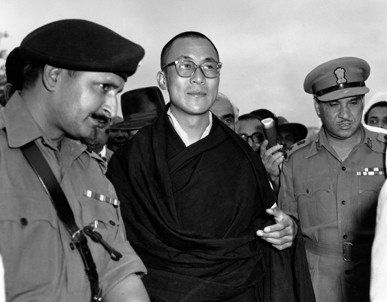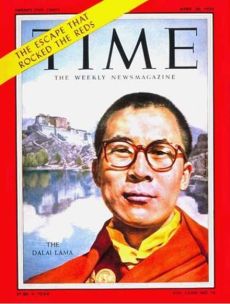A bit closer to the truth, but of course it is so much different from the American/British version which have their hidden agenda.

I read an article by Elisabeth Nauclrs in the Aug 22 edition of Hufvudstadsbladet (Hbl) in which she expresses anger with the Finnish government and president for not according the Dalai Lama an official reception. I have read other writings on the Dalai Lama’s visit in Hbl, too, and decided to tell the truth about Tibet and the Dalai Lama.
The Dalai Lama is neither the spiritual leader of Tibet nor does he represent the region. He is the leader of just the Yellow Hat (Gelug) sect of Tibetan Buddhism, which is dominant in Lhasa. Tibet has been an autonomous region ruled by local kings serving Chinese emperors since the 8th century.
The duties of the Dalai Lama, as well as the Panchen Lama, were prescribed relatively late by the Chinese rulers for helping them with the administration of the faraway and difficult-to-access region.
The Chinese rulers made it clear that the Lama had to pass on these duties to the next incarnation, to be found following strict historical and religious rules. But even after the new incarnation was found, the Chinese emperor had the right to veto the choice.
The incarnation of the 14th Dalai Lama, who is now based in Dharamsala, India, was approved by the then national government of China. In short, a living Dalai Lama cannot choose his follower all by himself.

The 14th Dalai Lama, after arriving in India in 1959
When the British invaded Lhasa in 1903 to snatch Tibet away from China, the 13th Dalai Lama disastrously declared that Tibetans were invulnerable, causing much bloodshed.
To escape the attack, the 13th Dalai Lama fled Tibet and took shelter in Inner Mongolia. The destitute Dalai Lama was soon found by the emperor and put under house arrest in a Tibetan prefecture of Qinghai province, where Baron Gustaf Mannerheim, then marshal of Finland, visited him in 1907.
The Russian czar, too, was interested in Tibet in order to expand his empire. But that stopped after the October Revolution.
The first decade of the 20th century was marked by political upheavals in China, and in chaos that followed the Boxer Rebellion, the Dalai Lama returned to Lhasa, which the British had left because they found it impossible to control the region for lack of transport facilities.
Tibet’s peaceful liberation was achieved in 1951. When the People’s Liberation Army entered Tibet in 1951, Chairman Mao Zedong was hailed as the liberator by the Tibetans and the Dalai Lama.

A 1959 cover of Time Magazine: It seems, according to a report from Germany’s Suddeutsche Zeitung, that when Tibet was occupied, The 14th Dalai Lama had to bend toward the temporal aspect of his post rather than the spirutual one, and agreed to CIA military aid for the Tibetan resistance.
The Dalai Lama got back part of his former powers and was made the vice-chairman of the National People’s Congress Standing Committee in 1954.
But these facts have been brushed under the carpet. What took place in 1951 was an internal change in China, and not the invasion of an “independent” country. In 1957, the Chinese leaders decided to end slavery in Tibet.
Then, only about 5 percent of the Tibetans were monks or nuns, or belonged to the small noble class or free nomadic hunting tribes. The rest were slaves who had to toil to feed the non-productive elite of the population. That’s why the monasteries, the house of the elites, saw the abolition of slavery as a catastrophe.
Since he wanted slavery to continue to maintain his status as a god, the Dalai Lama began spreading rumors that he could be jailed and even executed, which led to an uprising in 1959.
But security forces soon brought it under control. It was then that the Dalai Lama fled the country and was “installed” in Dharamsala by the British and Americans, who used him as a weapon against Mao.
And the CIA created the myth of the “father of the nation” fighting for the “freedom” of Tibet. The Dalai Lama may have ceased to be politically important, but the myth created around him survives.
Up to 1959, Tibet could be reached only through some horse-trails. The local economy was in tatters and education was the privilege of the elite.
Normal schools were forbidden. Only schools in monasteries that taught religious scriptures were allowed. Worse, the slaves were called “talking cattle” and treated no better than cattle.

Now Tibet has a modern railway and airports. Today, there are schools and colleges for everybody in Tibet, and Lhasa even has a modern university.
Besides, schools are free for ethnic Tibetans, who comprise 90.48 percent of Tibet’s 3 million population, whereas Han Chinese have to pay for education.
Tibet is China’s autonomous region like the Aland Islands are Finland’s (or Scotland is to the United Kingdom). The region has an autonomous government, local laws and regulations, and a governor that is necessarily an ethnic Tibetan.
But the local government is subordinate to the central government, not the Dalai Lama.
In 2008, the Dalai Lama/CIA tried again to fuel an uprising in Tibet with the intention of prompting an international boycott of the Beijing Olympic Games.
I was living in China then and wrote three articles for Finnish newspapers, laying bare the truth about the riots in Lhasa but they were not published because of censorship.
Only Hbl had the courage to publish one of my articles, but that was reduced to a small piece in “the reader’s voice”. Finland’s censorship is what forced me to try and get the English version of my rejected article published.
As a private person, I have visited Tibet and was free to move wherever and do whatever I liked. So I don’t have to base my article on the canards against China that find the prime of places and time slots in the international print and electronic media.
The author Mr. Eirik Granqvist is a Finnish scholar.
